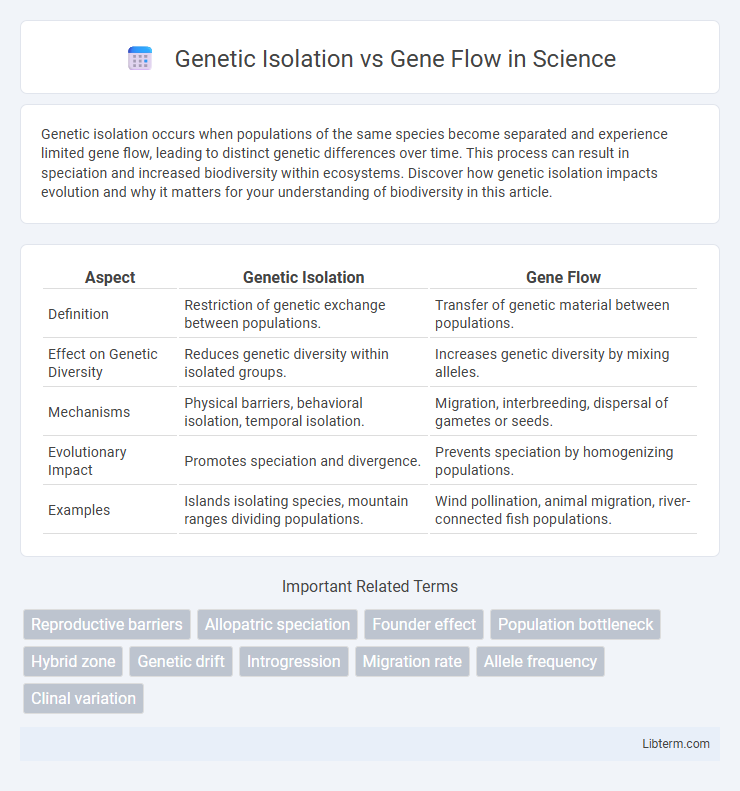Genetic isolation occurs when populations of the same species become separated and experience limited gene flow, leading to distinct genetic differences over time. This process can result in speciation and increased biodiversity within ecosystems. Discover how genetic isolation impacts evolution and why it matters for your understanding of biodiversity in this article.
Table of Comparison
| Aspect | Genetic Isolation | Gene Flow |
|---|---|---|
| Definition | Restriction of genetic exchange between populations. | Transfer of genetic material between populations. |
| Effect on Genetic Diversity | Reduces genetic diversity within isolated groups. | Increases genetic diversity by mixing alleles. |
| Mechanisms | Physical barriers, behavioral isolation, temporal isolation. | Migration, interbreeding, dispersal of gametes or seeds. |
| Evolutionary Impact | Promotes speciation and divergence. | Prevents speciation by homogenizing populations. |
| Examples | Islands isolating species, mountain ranges dividing populations. | Wind pollination, animal migration, river-connected fish populations. |
Introduction to Genetic Isolation and Gene Flow
Genetic isolation occurs when populations of the same species become separated, preventing gene exchange and leading to distinct genetic differences over time. Gene flow, in contrast, involves the transfer of genetic material between populations through migration and reproduction, increasing genetic diversity. Understanding the balance between genetic isolation and gene flow is crucial for studying evolutionary processes and species adaptation.
Defining Genetic Isolation
Genetic isolation occurs when populations of a species are physically or reproductively separated, preventing gene exchange and leading to distinct genetic pools. This separation can result from geographical barriers, behavioral differences, or temporal mating disparities. Over time, genetic isolation contributes to speciation as isolated populations accumulate unique genetic mutations.
Understanding Gene Flow
Gene flow refers to the transfer of genetic material between separate populations, which increases genetic diversity and reduces the effects of genetic isolation. It plays a crucial role in adapting species to changing environments by introducing beneficial alleles across populations. Understanding gene flow helps in conservation biology, as it aids in maintaining healthy populations and preventing inbreeding depression.
Mechanisms Leading to Genetic Isolation
Mechanisms leading to genetic isolation include geographic barriers such as mountains, rivers, and oceans that prevent gene flow between populations, resulting in allopatric speciation. Behavioral isolation arises when differences in mating rituals or timing reduce interbreeding, while mechanical isolation occurs due to incompatible reproductive structures. Temporal isolation also contributes by causing populations to breed at different times, limiting genetic exchange and promoting divergence.
Factors Promoting Gene Flow
Factors promoting gene flow include habitat connectivity, which allows individuals from different populations to migrate and interbreed, enhancing genetic diversity. Dispersal mechanisms such as wind, water currents, and animal movement facilitate the transfer of genes across geographic barriers. Human activities like habitat restoration and wildlife corridors further increase opportunities for gene flow by reducing fragmentation and connecting isolated populations.
Genetic Isolation: Evolutionary Consequences
Genetic isolation restricts gene flow between populations, leading to increased genetic differentiation and potentially speciation due to the accumulation of unique mutations. This isolation limits genetic diversity within populations, which can enhance local adaptation but also increases vulnerability to environmental changes and diseases. Over evolutionary timescales, genetic isolation drives divergent evolutionary paths, contributing to biodiversity by fostering distinct evolutionary lineages.
Gene Flow: Effects on Population Genetics
Gene flow introduces new alleles into a population, increasing genetic diversity and reducing the risk of inbreeding depression. It facilitates the spread of advantageous traits and helps maintain population adaptability in changing environments. By counteracting genetic drift, gene flow promotes genetic homogeneity between populations, influencing evolutionary trajectories.
Case Studies: Genetic Isolation in Nature
Genetic isolation occurs when populations of the same species become reproductively separated, leading to reduced gene flow and increased genetic divergence. Case studies such as the Galapagos finches illustrate how geographic barriers foster distinct genetic pools, driving speciation through isolated evolution. Similarly, island populations like the Hawaiian Drosophila demonstrate how limited gene exchange results in unique genetic adaptations and biodiversity.
Case Studies: Gene Flow in Action
Gene flow is exemplified in the case of the Galapagos finches, where inter-island mating has introduced genetic variation, promoting adaptability and reducing the risk of speciation through isolation. In contrast, the fragmented populations of Florida panthers exhibit genetic isolation, leading to inbreeding depression and decreased genetic diversity. Studies of these populations underscore the critical role of gene flow in maintaining genetic health and evolutionary potential across species.
Balancing Genetic Isolation and Gene Flow in Conservation
Balancing genetic isolation and gene flow is crucial for maintaining the genetic diversity and adaptive potential of endangered species in conservation efforts. Genetic isolation can prevent the spread of deleterious alleles but often reduces overall genetic variability, increasing extinction risk. Controlled gene flow through habitat corridors or managed translocations can enhance genetic diversity while preserving local adaptations in fragmented populations.
Genetic Isolation Infographic

 libterm.com
libterm.com